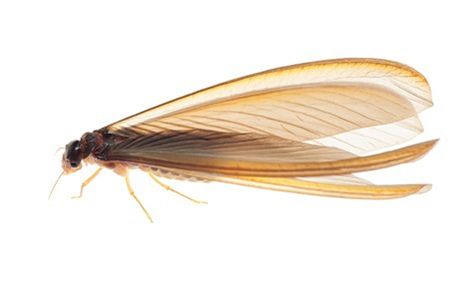
Termites
Termites: (Isoptera)
Description:
Termites are often not visible because they live in tunnels they dig inside wood, both above ground (dry wood termites), and underground (subterranean termites). In the United States, termites have been reported infesting houses as early as 1849. They are often first encountered as "appearing from nowhere" during a swarming event, or when cutting or breaking open infested wood. The most common termites encountered in Southern California are Drywood Termites (Incisitermes minor). They appear white (workers), to tan with darker heads (soldiers), Soldier termites have dark mandibles and will protect the colony from other insect invaders. They are about 3/8 of an inch long, with a large head and ring separations around their rounded abdomen. Termite reproductives grow two sets of wings and swarm in large numbers in the spring and fall. In the case of Drywood Termites, the presence of swarmers in a structure indicates that the colony has been established for at least five years.
Biology:
Termites are specialists at boring wood and eating the soft cellulose between the wood ribs. Subterranean termites reside in damp soil in search of decaying or buried wood. They will create mud tubes from ground level that extend into the ground floor wood framing of a structure infesting substructures of buildings. Drywood termites typically seek dry wood above ground, such as wood siding, window frames, and attics. Finding a pile of tiny pellets (like sand) that has fallen out of small holes in a piece of wood is, usually the prime evidence of a dry wood termite infestation. Termites reproduce in large numbers, so given time, they are capable of causing significant damage to your house or commercial building!
Did You Know?
They can eat more than just wood with some species feeding on organic matter or animal feces. Worker termites digest cellulose from food sources and regurgitate it into the mouths of soldier termites, who can't feed themselves. Termite queens can live for more than 25 years, and all termites together emit 150 million pounds of methane gas each year.
Impact:
Termites are a significant cause for concern for commercial property owners and homeowners. In the U.S. alone, the economic losses to property are in the billions of dollars annually. They destroy structures from the inside out causing severe structural damage.
Solutions:
It is important to have regular home termite inspections from a termite professional. Based on the termite inspection we may recommend treating just the infested area of a building or if the infestation is extensive, the situation may require fumigating the entire building. Subterranean termites can be found in sub-areas, under concrete slabs, and often enter through expansion joints or cracks in the foundation. Treatment can call for drilling and treating the subsoil. Additional treatment methods for subterranean termites include the use of underground bait stations. Wood that is specially baited with an approved termiticide is eaten and carried by the worker termites to their underground nest which could kill the whole colony before they have a chance to attack the building.
Additional Links
Subterranean
Termites
Drywood Termites
